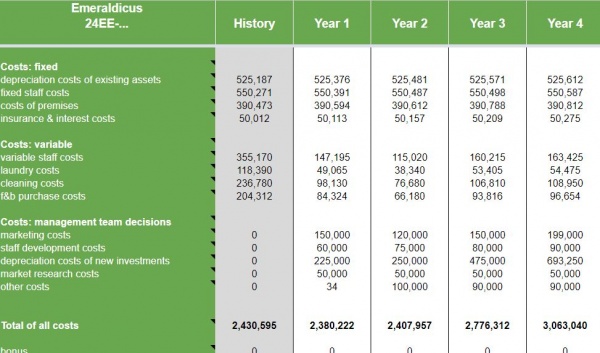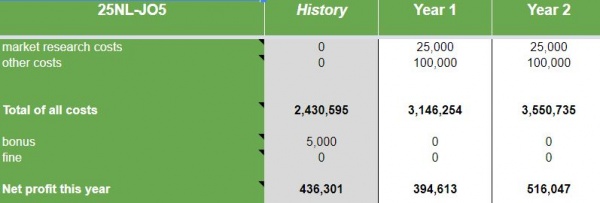Operating review
→ Go! Category:Hotel info
→ Go! Running competition
Operating review
An operational review is an in-depth look at the big picture, addressing in this case especially the financial elements so to
make the choices, costs, revenues and results clearly visible.
Divided into revenues and costs, in the administration of Emerald Forest Hotel, as we use it, no VAT Value added tax is visible. There is no record on the liquidity, balance sheets (opening nor end of the year) nor an investment plan.
We consider the revenues and the costs to be without any VAT and costs and revenues to be paid at the date they occurred.
. The total of the operating review is available as a operating review spreadsheet.
All Revenues
Revenues comprise the average (sales) prices the hotel had decided to chose, times the number of booked rooms (occupancy rate). All food and beverages are considered to be caused by these guests: so the higher the occupancy rate, the more revenues you get from food and beverages.
Banqueting and other revenues are a separated revenue unit in the hotel. The sales prices in the past varied from a minimum of € 25 to a maximum of € 30 per person. On the Banqueting page, you can find some more info, pictures, and videos on banqueting. The 'other' elements in this group are things like additional sales, renting out bikes, upgrades, cancellation fees etc. Altogether a bit more than 8% of the total revenues.
Underneath you'll find an overview which gives some more insights into the revenue structure, as far as information is available in the Bergman's administration. This all reflects the year before you take over, the history will be your starting position, the other years just give you an indication of what might happen.
| Revenues History | ||||
|---|---|---|---|---|
| Rooms | Rooms revenues weekend | € 704,340 | 24.61% | |
| Rooms revenues weekdays | € 1,244,880 | 43.49% | 68.10% | |
| Food and beverage | F&B revenues weekend | € 266,080 | 9.29% | |
| F&B revenues weekdays | € 414,960 | 14.49% | 23.78% | |
| Banqueting and other revenues | Banqueting and other revenues | € 231,636 | 8.09% | 8.09% |
| Total revenues | € 2,861,896 | 100% | 100% |
All costs
The situation below is just an example of the costs after four years. Again, the situations as you take over is the history (colored gray) the rest is example calculations.
Underneath you'll find an overview which gives further insights into the cost structure as far as information is available in the Bergman's administration. This all reflects the situation as you take over, this will be your starting position. Especially the Cost on management team decision are missing in the relevant year History. The four test year are just a basic testing in what this could bring. For now, this all is just zero. These management team decisions is what has been lacking, the last few years: you can not do without anymore.
| Costs | ||||
|---|---|---|---|---|
| Costs: fixed | Depreciation costs of existing assets | € 525,187 | 34.64% | |
| Fixed staff costs | € 550,271 | 36.29% | ||
| Costs of premises | € 390,473 | 25.75% | ||
| Insurance & interest costs | € 50,012 | 03.29% | ||
| Total fixed costs | € 1,515,943 | 100% | 62.36% | |
| Costs: variable | Variable staff costs | € 355,170 | 38.95% | |
| Laundry costs | € 118,390 | 12.94% | ||
| Cleaning costs | € 236,780 | 25.88% | ||
| F&B purchase costs | € 204,312 | 22.33% | ||
| Total variable costs | € 914,652 | 100% | 37.63% | |
| Costs: management team decisions | Marketing costs | € 0 | 00.00% | |
| Staff development costs | € 0 | 00.00% | ||
| Extra depreciations costs | € 0 | 00.00% | ||
| Market research costs | € 0 | 00.00% | ||
| Other costs | € 0 | 00.00% | ||
| Total management team decisions costs | € 0 | 100% | 00.00% | |
| Total all costs | € 2,430,595 | 100% |
The different costs groups are all mentioned in the operating review table above.
Keep in mind that calculations are never 'perfect'. Calculation on the revenues on rooms weekend, for instance:
is 52 weeks x 100 rooms x 43% weekdays (3 nights out of 7) x 7 days a week = 15.652 nights x occupancy rate (starts at 50%) x average price (rack rate and last-minute). There is always a difference to the outcome of this calculation and the 'reality': caused by cancellations, refunds, double bookings, short stays, rounding-up numbers, missing one day in a year etc. There is no record on all of this. This all together might bring a difference up to a few percent in the expected revenues linked to the occupancy rate.
You cannot influence these costs at all. These are costs which will be created no matter what the occupancy rate is. Over the years there can be small fluctuations, but the amounts will stay almost the same.
- Depreciation costs of existing assets: depreciation of all the assets especially the building, fixtures and fittings.
- Fixed staff costs: staff needed to run the hotel and which have to be paid even if there are no guests at all.
- Costs of premises: costs of maintenance, repairs on small adaptions to the building and the parking lots.
- Insurance & interest costs: costs for insurance for staff, building a liability and costs for mortgage and other loans.
The variable costs will depend on the actual number of guests in the hotel. There is a ratio between occupancy rate and all of these costs. You cannot influence this, but it will be influenced by the occupancy rate you have created with the way of managing the hotel.
- Variable staff costs: the more guest you have, the more work here will be to be done and the more staff is needed. So additional costs.
- Laundry costs: the more guest the more towels, bed linen etc. needed.
- Cleaning costs: rooms need to be cleaned more often because of more guests and to be cleaned better.
- F&B purchase costs: more guest means more breakfasts etc. for guest and more f&b for additional staff so the purchase costs go up.
All of your decisions (numbers 6 -10) lead directly to costs which can be seen directly on the costs side. They are directly connected to the situation the family Bergman explained: they have been neglected. As you can see in the past there were no costs made regarding these decisions. Of course, this was good for the profit but it will come back like a boomerang! So the family urges the new management to use this costs group team decisions in an efficient way. The screenshots just show a few years as example during some testing with the accountant. The history is the only valid, last year's result.
- Net profit
Of course, the net profit per year is very interesting. The total costs will be deducted from the total revenues. If there is a bonus (something which turned out much better then expected) or a fine (tax e.g.) this is added or deducted from the profit leading to the net profit.
In this example on taking over:
- Total revenues were € 2,866,902
- Total costs € 2,430,595
- Net profit € 436,301
The balance sheets just show the individual profit of the last year in the operating review and the total of the net profit.
Key metrics
Some key metrics and ratios on the operations of your hotel in this section.
Net profit once again showed here, but now linked to the total net profit. So adding up the profit of all years passed.
The number of guests gives you an indication which numbers pass through your hotel in a year.
Your hotel is ranked on net profit as well as on creativity. Both rankings are within your city.
There is ranking on creativity, this is linked to what you have done in all of the years related to creativity and evaluated by your coach. You can have any position depending on the number of hotels in your city.
Market research costs and other costs
The are standard element sin a hotel operating review. Both, again, are not used n the history. Some exercising with numbers is visible in the four test years.
Analysing
So the net profit on taking over seems to be 15.21% of the revenues, a good and interesting result.
But, the management did not make enough investments over the recent years, so the depreciation costs have been kind of low. There is no problem with liquidity at all.
Furthermore, the Bergmans did not really consider themselves to be staff, so there are hardly any wages for them in the staff costs. Their income mainly originated from the net profit which they, partly, took out of the company, being the entrepreneurs.
Calculate yourself?
If you want to make calculations yourself, you can, in the top menu download the Team File as Excel file. Store this one on your computer and you can do some calculations in this version (which now, of course, has no longer links to the real one and new changes in the online one).
→ Go! Following the Introduction to the Hotel? Step 910/10 is the page Operating review
→ GO! Top of this page



